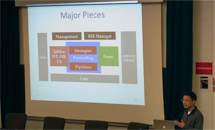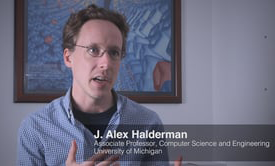The NDN project team compiles and publishes this newsletter monthly to inform the community about recent activities, technical news, meetings, publications, presentations, code releases, and upcoming events. You can find these newsletters posted on the Named Data Networking Project blog.
Community Outreach
- PI Christos Papadopoulos presented “Named Data Networking in Climate Research and HEP Applications” at the 21st International Conference on Computing in High Energy and Nuclear Physics (CHEP 2015). Additionally, a group from Imperial College London presented “Possibilities for Named Data Networking in HEP” whereby they built the NDN platform on Centos7 and built a custom C++ application to provide repository services (“repose”). The application is built against lib-ndncxx to connect it to NDN and to backend filesystem libraries librados (part of Ceph) & libcurl The backends serve files into the NDN namespace from either a conventional POSIX filesystem, Ceph or HTTP source (currently read-only client pending solution for authentication).
- PI Lixia Zhang visited Peking University (PKU) on April 23 where she presented “Tackling the Challenge of Developing A New Internet Architecture” followed by a long Q&A session. Lixia also visited the Institute of Computer Network and Information System at PKU to hear about their ongoing effort with NDN related research.
- PIs Jeff Burke and Lixia Zhang visited Tsinghua University on April 24 to attend a mini-NDN workshop, organized by Prof. Dan Pei, where professors and graduate students presented their NDN related projects:
- Yet Another View on the Pending Interest Table. By Huichen Dai
- Hop-adoptive Storage-forwarding Network. By Prof. Bin Liu
- Transform HTTP to NDN: How does NDN support Web Content Delivery? By Zhaogeng Li
- Adaptive NDN Video Delivery over WLAN. By Menghan Li
- Adaptive NDN Forwarding through probing.
After the mini-workshop we discussed collaboration with Prof. Dan Pei’s group on the NDNFit project.




